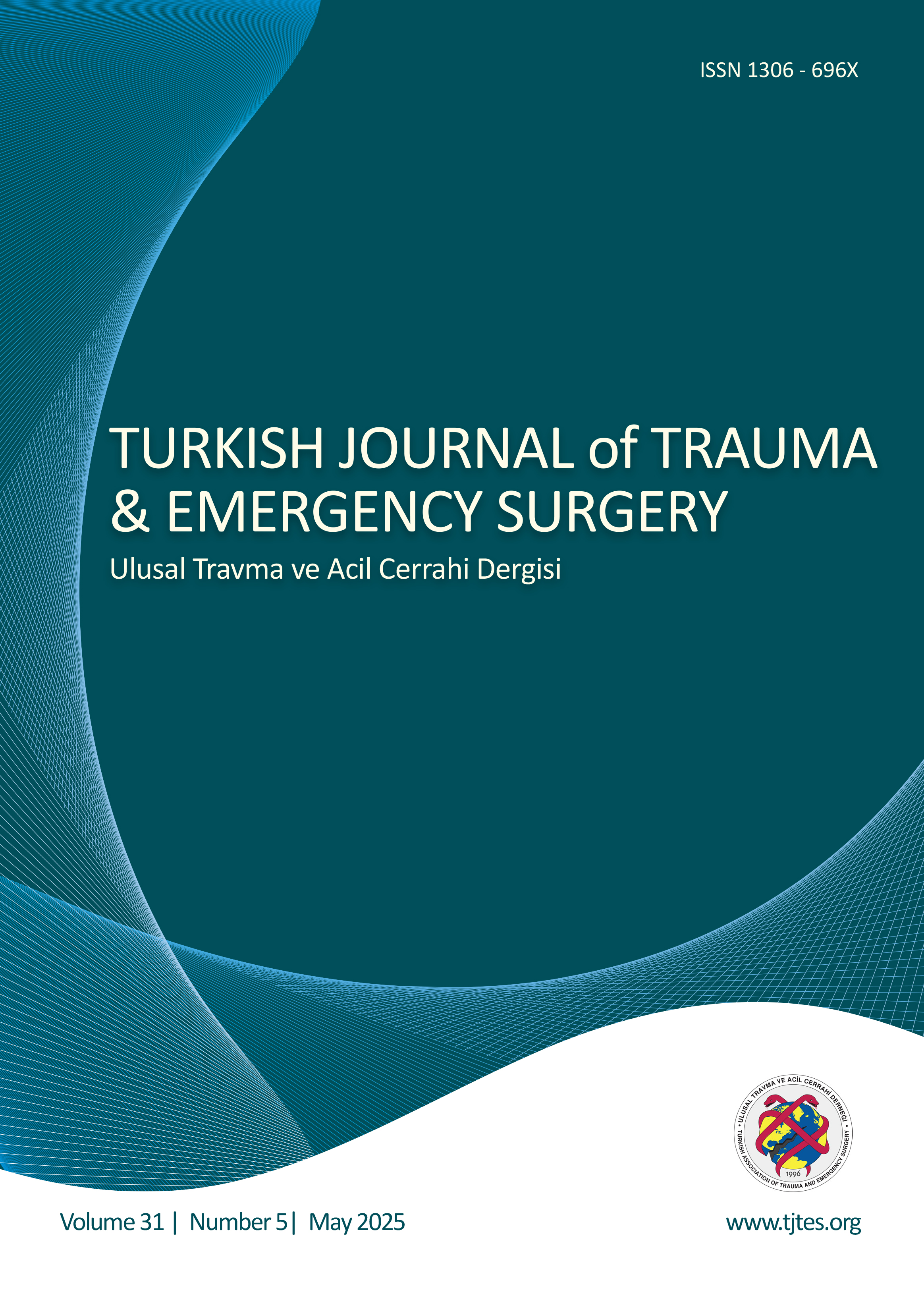Hızlı Arama
Toraks travmalarına bağlı geç komplikasyonlar
Duygu Mergan İliklerden1, Ufuk Çobanoğlu1, Fuat Sayır1, Ümit Haluk İliklerden21Yüzüncü Yıl Üniversitesi Tıp Fakültesi, Göğüs Cerrahisi Anabilim Dalı, Van2Yüzüncü Yıl Üniversitesi Tıp Fakültesi, Genel Cerrahi Anabilim Dalı, Van
AMAÇ: Kliniğimize Mart 2010Aralık 2019 tarihleri arasında toraks travması sonucu müracaat etmiş 412 olgu geriye dönük olarak incelenerek, künt ve penetran toraks travmaları sonucu gelişen geç komplikasyonlar değerlendirilmiş ve travmayla ilgilenen hekimlere bu komplikasyonların yönetimi için bir öngörü sunulması amaçlanmıştır.
GEREÇ VE YÖNTEM: Dört yüz on iki toraks travmalı olgudan bu çalışmanın ana temasını oluşturan geç dönem komplikasyon gelişmiş 62 olgu (%15.04) yaş, cinsiyet, travma tipi, travma nedeni, travmanın ilk geliştiği dönemde gelişen toraks patolojileri ve yandaş organ patolojileri, gelişen geç dönem komplikasyonları ve bunlara yönelik tedavi yöntemleri ile mortalite açısından incelendi.
BULGULAR: Toraks travmasına bağlı geç komplikasyon gelişmiş 62 olgunun 47si (%75.80) erkek, 15i (%24.20) kadın, yaş ortalaması 56.98±21.22 olarak tespit edildi. Posttravmatik geç dönem komplikasyon gelişen olguların travma tipi değerlendirildiğinde künt travmaların %90.33 (n=56), penetran travmaların %9.47 (n=6) oranında olduğu ve künt travma olgularında en sık nedenin trafik kazası (%66.07), penetran travmalarda ise delici-kesici alet yaralanması (%83.33) olduğu saptandı. En sık gelişen toraks patolojisi künt travmalarda pulmoner kontüzyon (%75), penetran travmalarda ise hemopnömotoraksdır (%66.66). Gruplar ayrı ayrı incelendiğinde penetran travmalar için en sık görülen geç dönem komplikasyon retansiyone hemotoraks (%66.66) iken, künt travmalı olgularda en sık (%41.07) pnömonidir. Retansiyone posttravmatik hemotoraks tablosu ile gelen hastaların 17sinde video yardımlı torakoskopik cerrahi, sekiz olguya torakotomi uygulandı. Posttravmatik ampiyemle gelen olguların yedisine torakoskopi, dört olguya torakotomi ile dekortikasyon yapıldı. Geç komplikasyon gelişen olguların altısı hayatını kaybetdi. Mortalite oranı %9.67dir. Mortalite gelişen olguların %83.33ünde geç komplikasyon türü olarak pnömoni tespit edildi.
TARTIŞMA: Travma ile ilgilenen hekimlerin, ilk bakıda tespit edemeyecekleri ve daha sonra karşılarına gelebilecek geç dönem komplikasyonlar açısından, hastanın yaşı, tavma tipi başta olmak üzere birçok etken faktörü gözününde bulundurarak hastasının tedavi modalitelerini belirlemeleri uygun olacaktır.
Late complications due to thoracic traumas
Duygu Mergan İliklerden1, Ufuk Çobanoğlu1, Fuat Sayır1, Ümit Haluk İliklerden21Department of Thoracic Surgery, Yüzüncü Yıl University Faculty of Medicine, Van-Turkey2Department of General Surgery, Yüzüncü Yıl University Faculty of Medicine, Van-Turkey
BACKGROUND: A total of 412 patients who applied to our clinic after a thoracic trauma between March 2010 and December 2019 were examined retrospectively In this study, late complications that developed as a result of blunt and penetrating thoracic traumas were evaluated and it was aimed to present a prediction for the management of these complications to physicians who are dealing with trauma.
METHODS: Among the 412 thoracic trauma cases, 62 cases (15.04%) who developed late-term complications which constituted the main theme of this study were evaluated in terms of age, gender, the type of trauma, the cause of trauma, thorax, and concomitant organ pathologies that developed when the trauma first occurred, the late-term complications, and the treatment methods for them while considering mortality.
RESULTS: Of 62 patients with late complications due to thoracic trauma, 47 (75.80%) were male, 15 (24.20%) were female, and the average age was 56.98±21.22. When the trauma type of the patients who developed posttraumatic late-term complications was evaluated, blunt traumas were seen in 90.33% (n=56) of the cases, whereas penetrating traumas were seen in 9.47% (n=6). Traffic accidents were the most common cause in blunt trauma cases (66.07%), whereas pointed and sharp-edged weapon injuries were the most common in penetrating traumas (83.33%). The most common thorax pathology is pulmonary contusion (75%) in blunt traumas and hemopneumothorax in penetrating traumas (66.66%). When the groups were analyzed separately, the most common late-term complication for penetrating traumas was retained hemothorax (66.66%), while pneumonia was the most common (41.07%) in blunt trauma cases. Video-assisted thoracoscopic surgery was performed in seventeen patients with retained post-traumatic hemothorax and thoracotomy was performed in eight cases. Seven patients with post-traumatic empyema underwent thoracoscopy, and four patients underwent decortication with thoracotomy. Six of the patients who developed late-term complications died. The mortality rate is 9.67%. Pneumonia was detected as a late complication type in 83.33% of cases with mortality.
CONCLUSION: It will be appropriate for the physicians who are interested in trauma to determine the treatment modalities of the patients by considering many factors such as the age of the patient and the trauma type in terms of the late complications that they will not be able to detect at first glance.
Makale Dili: İngilizce




